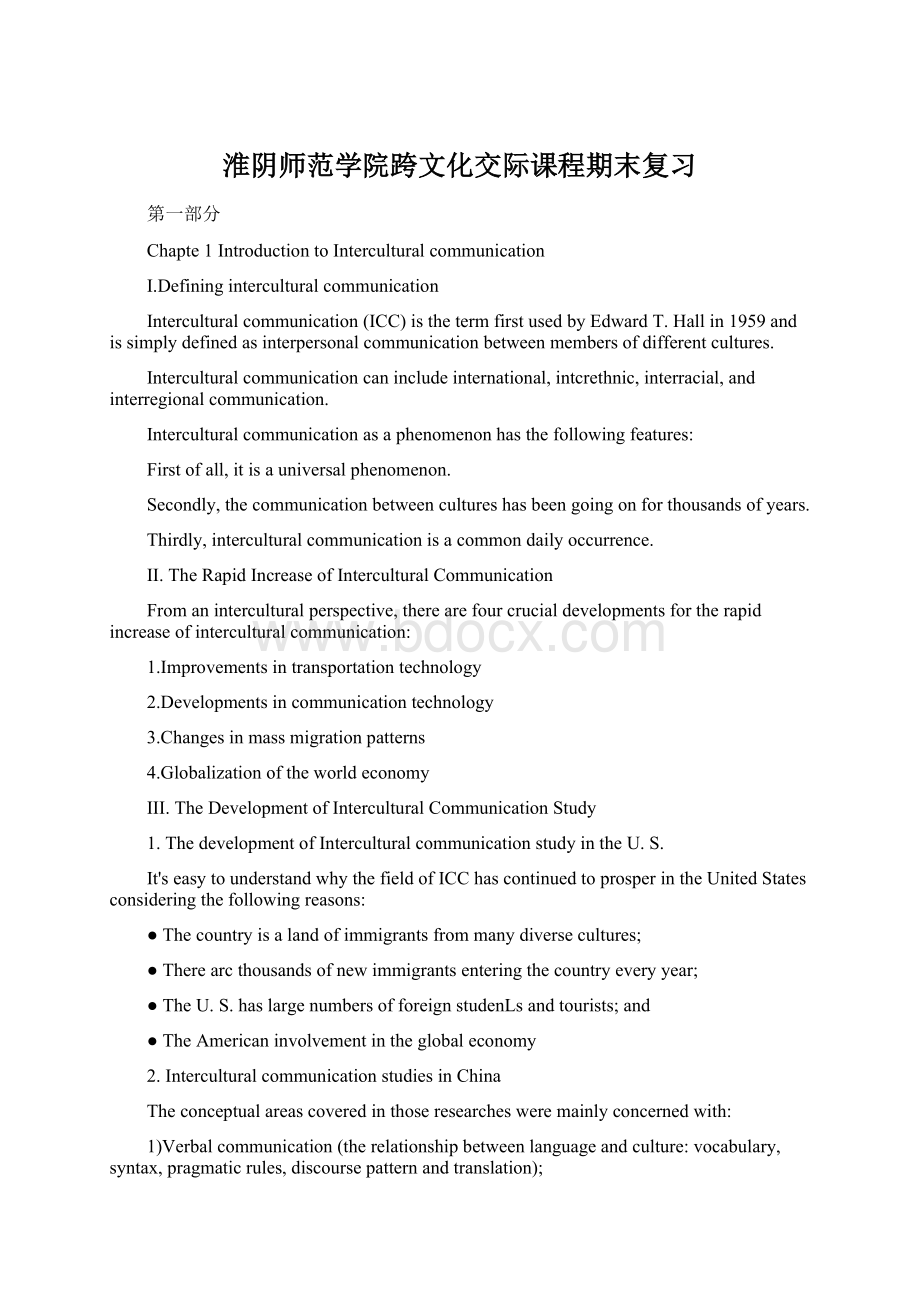淮阴师范学院跨文化交际课程期末复习Word文件下载.docx
《淮阴师范学院跨文化交际课程期末复习Word文件下载.docx》由会员分享,可在线阅读,更多相关《淮阴师范学院跨文化交际课程期末复习Word文件下载.docx(37页珍藏版)》请在冰豆网上搜索。

4.Globalizationoftheworldeconomy
III.TheDevelopmentofInterculturalCommunicationStudy
1.ThedevelopmentofInterculturalcommunicationstudyintheU.S.
It'
seasytounderstandwhythefieldofICChascontinuedtoprosperintheUnitedStatesconsideringthefollowingreasons:
●Thecountryisalandofimmigrantsfrommanydiversecultures;
●Therearcthousandsofnewimmigrantsenteringthecountryeveryyear;
●TheU.S.haslargenumbersofforeignstudenLsandtourists;
and
●TheAmericaninvolvementintheglobaleconomy
2.InterculturalcommunicationstudiesinChina
Theconceptualareascoveredinthoseresearchesweremainlyconcernedwith:
1)Verbalcommunication(therelationshipbetweenlanguageandculture:
vocabulary,syntax,pragmaticrules,discoursepatternandtranslation);
2)Non-verbalcommunication;
3)ComparativestudyofcustomsandbehaviorpatternsinChinaandothercountries;
4)Culturaldifferencesinbusinessmanagement;
5)TraditionalChinesevalueorientationsandtheirimpactonmodernization,etc.
IV.TheComplexityinLearningInterculturalCommunication
1.Themultidisciplinarynatureandelementsofinterculturalcommunicationstudy
JamesAlutissummarizedthemultidisciplinarynatureofICCas"
LAPSE"
:
L-Linguisticsandlanguage
A-Anthropology
P-PsycholinguisticsandPsychology
S-SociolinguisticsandSociology
E-EducationandEnglish
Inadditiontotheabovenameddisciplines,ICCisalsorelatedtoseveralotherdisciplines,suchas
C-Communicationstudies
C-Culturalstudies,etc.
ElementsofICCStudy
Condon(1974)highlightedthreeareasasmostproblematicininterculturalexchange:
languagebarrier,differentvaluesanddifferentculturalpatternsofbehavior.Morespecifically.Bell(1992)identifiedthefollowingbarrierstocommunication;
Physical—time,environment.comfortandneeds,andphysicalmedium;
Cultural—ethnic,religious,andsocialdifferences;
Perceptual—viewingwhatissaidfromyourownmindset;
Motivational—thelistener'
smentalinertia;
Experiential—lackofsimilarlifehappenings;
Emotional—personalfeelingsofthelistener;
Linguistic—differentlanguagesspokenbythespeakerandlisteneroruseofavocabularybeyondthecomprehensionofthelistener;
Nonverbal—nonwordmessages;
Competition—thelistener'
sabilitytodootherthingsratherthanhearthecommunication
2.Potentialproblemsinlearninginterculturalcommunication
Communicationbarriersareobstaclestoeffectivecommunication.
Bamasuggeststhattherearesixmain"
stumblingblocks"
whichoftencausedifficultiesininterculturalcommunication;
1)Peopletendtoassumethattherearemoreculturalsimilaritiesbetweenthemselvesandpeopleofotherculturesthanthereactuallyarc,andthiscanleadtomisunderstanding.
2)Languagedifferences,obviously,areoftenasourceofmisunderstanding.
3)Peopleofdifferentculturesoftenmisinterpreteachother'
snon-veibalcommunication.
4)Peopleoftenhavestereotypesandpreconceptionsabout"
foreigners"
thatleadtomisunderstanding.
5)Peopleoftenevaluatewhat"
foreigners"
doandsaybeforereallyunderstandingwhattheymean.
6)Whenpeopleinteractwithforeigners,theyoftenhavefeelingsofanxietyorstress,andthiscanleadthemtojumptoinaccurateconclusions.(Onesourceofthisstressissometimes"
culturalshock."
)
Specifically,it'
sgenerallyagreedthaithepotentialproblemsininterculturalcommunicationarcmainlythefollowing:
AvoidanceoftheunfamiliarUncertainlyreductionWithdrawalStereotypingPrejudiceRacismMisuseofpowerCultureshockEthnocentrism
Cultureshockisprecipitatedbytheanxietythatresultsfromlosingallourfamiliarsignsandsymbolsofsocialintercourse.
peoplenormallygothroughfourstages(theU-Curve):
honeymoonphase,cultureshockphase,recoveryphaseandadjustmentphase.
Chapter2BasicCommunicationTheories
I.CommunicationDefined
wecanseethatthebasicassumptionis;
Communicationisaformofhumanbehaviorderivedfromaneedtoconnectandinteractwithotherhumanbeings.Therefore,communicationcansimplyrefertotheactandprocessofsendingandreceivingmessagesamongpeople.
thedefinitionadvancedbySamovarandPorter(1997)ispreferredhere:
"
Communicationoccurswhenevermeaningisattributedtobehaviorortheresidueofbehavior."
II.NeedsandFunctionsofCommunication
1.Maslow'
shierarehyofneeds
Onemuch-usedversionofneedsisthatofAbrahamMaslow'
inwhichhedescribespeopleasbeingdrivenbysetsofneedsinahierarehy,fromthemostbasicatthebottomtothemostrefinedatthepeakofatriangle.
Basicneedsareaboutfood,shelterandsex.Justabovethatcometheneedsofsafety—havingaroofoverone'
sheadandknowingthatonebelongstosomegrouplikefamily.Thentherearethesocialneedsforthingslikeloveandfriendship,whichurgeusintorelationships.Thesearefollowedbyegoandesteemneeds,whichareaboutusasindividualswantingself-respect,recognition,evenpower.Finally,atthetopofthetrianglecomesthemostsophisticatedneed—forself-actualization.Thisisaboutself-fulfillment,aboutfindingandbeingoneself.
2.Functionsofcommunication
●Practicalfunction.
●Socialfunction.
●Decisionmakingfunction
●Personalgrowthfunction
III.TheClassificationofCommunication
Fromtheabovediscussionwecanseethatcommunicationoccurswhen—
●thereareatleasttwoormorepeople.
●thereissomecontactbetweencommunication.
●thereisalanguagesharedbycommunicators.
●thereisanexchangeofinfommlionthathastakenplace.
IV.TheProcessofCommunication
1.Componentsofcommunication
SamovarandPorter(1997)furtherdefinecommunicationas"
adynamictransactionalbehavior-affectingprocessinwhichpeoplebehaveintentionallytoinduceorelicitaparticularresponsefromanotherperson"
Somepeoplesayeightspecificcomponentsaddingencodinganddecoding.
●sender/behaviorsource
●encoding
●message
●medium/channel
●decoding
●recipient(receiver)/responder
●noise
●feedback
2.Modelsofcommunication
Althoughtherearcmanymodelstodescribetheactofcommunication.threearcusedheretoillustratetheprocess;
thelinear,thecircular,andthecontextualizedmodels.
V.TheCharacteristicsofCommunication
Theseeightingredientsofcommunicationmakeuponlyapartiallistofthefactorsthatfunctionduringacommunicationevent.
●CommunicationisDynamic.
●CommunicationisIrreversible.
●CommunicationisSymbolic.
●CommunicationisSystemic.
●CommunicationisSelf-reflective.
●CommunicationisInteractive.
●CommunicationisComplex.
●CommunicationisLearned.
VI.TheChallengeofEffectiveCommunicationinInterpersonalEncounters
Efficientcommunicationsbetweenpeopleofthesameculturalbackgroundareextremelyimportant,letaloneinterculturalcommunicationbetweenpeopleofdifferentculturalbackgrounds.
Chapter3TheNatureofCulture
Ⅰ.DefinitionsofCulture
●AccordingtotheConciseOxfordDictionary,cultureis"
theartsandothermanifestationsofhumanintellectualachievementregardedcollectively"
.Itreferstointellectualperspective,suchasmusic,artexhibition,dance,etc.WhenyoutalkaboutPicasso.Beethovenetc.,youaretalkingaboutculture;
●Samovar&
Porter(1996)definecultureas"
thedepositofknowledge,experience,beliefs,values,attitudes,meanings,hierarchies,religion,notionsoftime,roles,spatialrelations,conceptsoftheuniverse,andmaterialobjectsandpossessionsacquiredbyagroupofpeopleinthecourseofgenerationsthroughindividualandgroupstriving."
(p.36)Wefindthisdefinitionmoresuitedtoourpurposeofstudyinginterculturalcommunication.Simplyput,cultureisasystemofmeaning.
●Butthemostwidelyacccpteddefinitionis:
Cultureisthetotalaccumulationofbeliefs,customs,values,behaviors,institutionsandcommunicationpatternsthatarcshared,learnedandpasseddownthroughthegenerationsinanidentifiablegroupofpeople."
(Hall.1983,p.230)
●Morerecently,GaryP.Fcrraro(1998,TheCulturalDimensionofInternationalBusiness,NewYork:
Prcnticc-Hall,Inc.)offersabrieferdefinition;
Cultureiseverythingthatpeoplehave,think,anddoasmembersoftheirsociety,"
(p.16)
II.BasicFunctionsandSourceofCulture
DressierandCams(1969)offertthefollowingasthefunctionsofculture:
1.Cultureenablesustocommunicatewithothersthroughalanguagethatwehavelearnedandthatweshareincommon.
2.Culturemakesitpossibletoanticipatehowothersinoursocietyarelikelytorespondtoouractions.
3.Culturegivesusstandardsfordistinguishingbetweenwhatisconsideredrightorwrong,beautifulandugly,reas